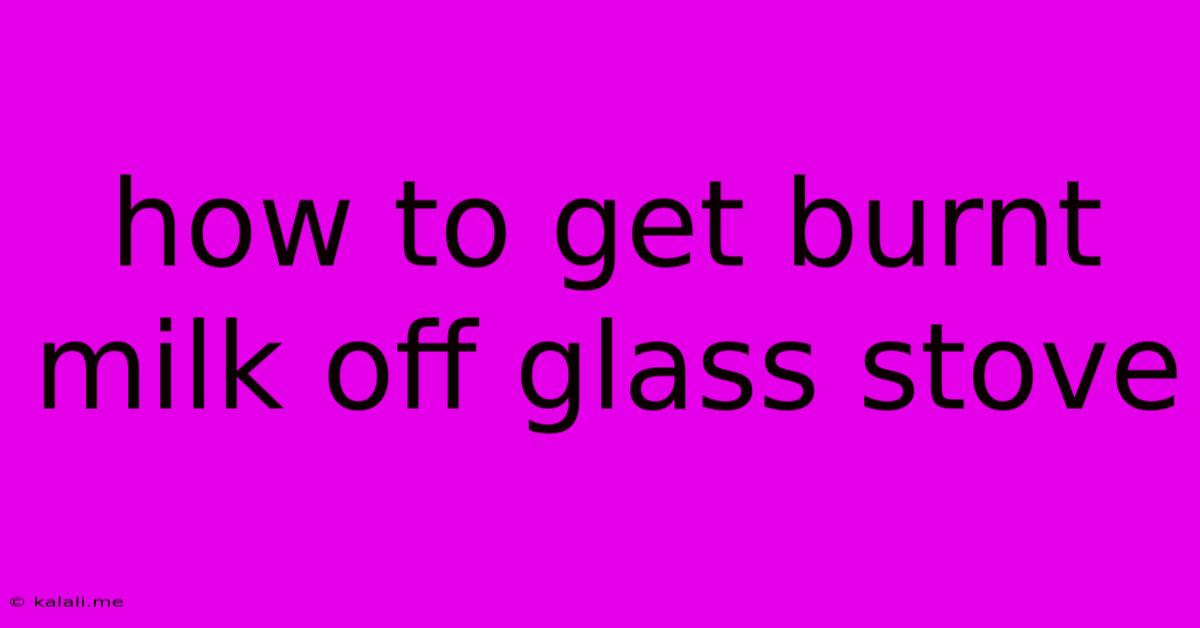How To Get Burnt Milk Off Glass Stove
Kalali
Jun 02, 2025 · 3 min read

Table of Contents
How to Get Burnt Milk Off a Glass Stovetop: A Step-by-Step Guide
Burnt milk is a kitchen nightmare, especially when it's caked onto your sleek glass stovetop. That stubborn, caramelized mess can seem impossible to remove, but with the right techniques and a little patience, you can restore your stove to its pristine condition. This guide provides effective methods to tackle burnt milk residue, leaving your glass stovetop sparkling clean.
Understanding the Problem: Burnt milk contains sugars that caramelize and harden upon contact with high heat. This creates a sticky, tenacious residue that's resistant to simple wiping. The longer it sits, the more difficult it becomes to remove. Immediate action is key to preventing a major cleaning ordeal.
Method 1: The Baking Soda Paste Approach (For Fresh Spills)
This method is ideal for tackling relatively fresh burnt milk spills. The baking soda acts as a gentle abrasive, while the water creates a paste that helps lift the residue.
- What you'll need: Baking soda, water, a non-abrasive sponge or cloth, a scraper (optional).
- Steps:
- Let it cool: Ensure the stovetop is completely cool before you begin cleaning.
- Make the paste: Mix baking soda with a small amount of water to form a thick paste.
- Apply the paste: Generously apply the paste to the burnt milk area.
- Let it sit: Allow the paste to sit for at least 15-20 minutes to soften the burnt milk.
- Scrub gently: Use a non-abrasive sponge or cloth to gently scrub the paste into the burnt milk. A scraper can help loosen stubborn bits.
- Wipe clean: Rinse the area thoroughly with clean water and wipe dry with a soft cloth.
Method 2: The Vinegar and Water Soak (For Stubborn Stains)
For older, more stubborn burnt milk stains, a vinegar and water soak can be more effective. The acidity of the vinegar helps break down the caramelized sugars.
- What you'll need: White vinegar, water, a spray bottle, a non-abrasive sponge or cloth, a scraper (optional).
- Steps:
- Cool down: Make sure the stovetop is cool.
- Prepare the solution: Mix equal parts white vinegar and water in a spray bottle.
- Saturate the area: Liberally spray the burnt milk area with the vinegar solution.
- Let it soak: Allow the solution to soak for at least 30 minutes, or even longer for very stubborn stains.
- Scrub and wipe: Use a non-abrasive sponge or cloth to gently scrub the area. A plastic scraper can assist in removing stubborn residue. Be careful not to scratch the glass surface.
- Rinse and dry: Rinse thoroughly with clean water and wipe dry with a soft cloth.
Method 3: The Commercial Cleaner Route
If the above methods prove ineffective, you can try a commercial glass cooktop cleaner. Always follow the manufacturer's instructions carefully and test a small, inconspicuous area first to ensure it doesn't damage your stovetop.
Prevention is Key: Tips to Avoid Burnt Milk Spills
- Low and slow: Use a lower heat setting when heating milk to prevent burning.
- Constant attention: Never leave milk unattended while it's heating.
- Stir regularly: Stirring frequently prevents milk from sticking to the bottom of the pan.
- Use a heavy-bottomed pan: Heavy-bottomed pans distribute heat more evenly, reducing the risk of burning.
- Clean up immediately: Address spills as soon as they happen, before the milk has a chance to harden.
By following these methods and preventative tips, you can keep your glass stovetop clean and free of those pesky burnt milk stains. Remember patience and gentle scrubbing are key to success! Avoid harsh abrasives, as they can scratch the surface of your glass stovetop.
Latest Posts
Latest Posts
-
How To Check Where Someone Last Died Mc
Jun 04, 2025
-
Best Heat Exhaust Duct That Leak Out Heat
Jun 04, 2025
-
Oni Not Melting At Mely Point
Jun 04, 2025
-
2 Way V 3 Way Switch
Jun 04, 2025
-
What Happens If You Dont Appear For Jury Duty
Jun 04, 2025
Related Post
Thank you for visiting our website which covers about How To Get Burnt Milk Off Glass Stove . We hope the information provided has been useful to you. Feel free to contact us if you have any questions or need further assistance. See you next time and don't miss to bookmark.